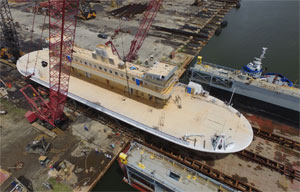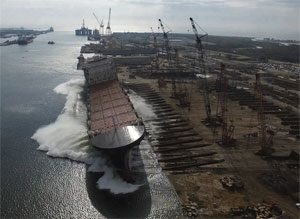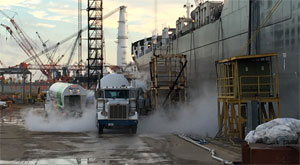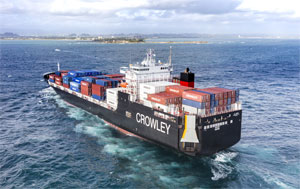Building ships with liquefied natural gas (LNG) propulsion comes with numerous challenges. Bunkering them for the first time probably isn’t the first issue that comes to mind.
VT Halter Marine faced that dilemma last summer as El Coqui, Crowley Maritime’s lead LNG-powered container/roll-on/roll-off ship (con-ro), approached sea trials. Trucks loaded with the fuel traveled from Jacksonville, Fla., to the Pascagoula, Miss., shipyard to fuel the newly built ship. The process was a true learning experience.
“For the first vessel, El Coqui, it took us about 15 days to bunker it the first time. It involves cooling tanks with nitrogen before putting fuel in there so it doesn’t flash to gas,” VT Halter CEO Ronald Baczkowski explained in a recent interview at the 84-acre shipyard. “And it was in South Mississippi, hot, humid, with a line of fueling trucks waiting to offload their product onto the ship.”
Throughout the build process for the 720-foot El Coqui and sister vessel Taino, the yard learned valuable lessons working with the LNG propulsion system and the fuel itself. So when it came time to bunker Taino in late 2018, the process “worked like a Swiss watch,” Baczkowski said.
 |
|
VT Halter CEO Ronald Baczkowski |
|
Courtesy VT Halter Marine |
“With Taino, we factored in six days for bunkering, but we achieved it in four days,” he said, adding that “we did learn some hard lessons on Crowley. But we learned them, and we’ve applied them to future programs.”
VT Halter, a subsidiary of Singapore-based ST Engineering, expects those hard lessons to pay off as the Jones Act shipping market moves toward wider adoption of LNG propulsion. There are more immediate benefits too, particularly as the shipyard continues work on the first Jones Act-compliant offshore LNG bunkering barge for Q-LNG. The barge will pair up as an articulated tug-barge (ATB) unit.
The first ATB, with its 4,000-cubic-meter capacity barge, is scheduled to leave VT Halter’s shipyard in early 2020. Harvey Gulf will operate the vessels under charter to Shell. The shipyard also has received inquiries from other operators interested in LNG projects. LNG burns cleaner than marine diesel but isn’t widely available even in large U.S. ports, creating opportunities for LNG bunkering vessels.
VT Halter isn’t the only American shipyard with LNG shipbuilding experience. General Dynamics NASSCO in San Diego completed Isla Bella and Perla del Caribe more than three years ago for TOTE Maritime. Philly Shipyard also has built a half-dozen “LNG-ready” ships for several U.S.-flagged operators, though these vessels are currently burning marine diesel. For now, TOTE’s two containerships and Crowley’s two con-ros are the only vessels in the Jones Act cargo trade burning LNG.
 |
|
VT Halter’s recent portfolio of niche vessels includes Powhatan, a new ferry built for the Virginia Department of Transportation. The 270-foot vessel is shown being moved onto a dry dock prior to being launched in August. |
|
Courtesy VT Halter Marine |
“Clearly, we see an interest in LNG,” Baczkowski said. “We feel very fortunate to be out in front.”
Baczkowski became CEO of VT Halter in mid-2018. He spent 32 years in the U.S. Marine Corps, where he rose to the rank of brigadier general before retiring in 2012. He joined VT Systems, which focuses on marine engineering, in 2016. He served as vice president of business development before his promotion to chief executive. He has assembled a team that includes longtime shipbuilding industry veteran Robert Socha as a senior vice president, among other hires.
Baczkowski arrived during a challenging period for VT Halter, Mississippi’s second-largest shipyard behind nearby Huntington Ingalls. VT Halter occupies a unique niche in the industry with a focus on medium and large military, government and commercial vessels that require complex engineering. Its commercial sector work takes advantage of that engineering expertise when building complex ships and barges for the petroleum and chemical sectors, as well as other niche vessels.
Since Baczkowski took over, VT Halter has announced several new orders, including a series of barracks barges for the U.S. Navy and a contract potentially worth more than $150 million for a new National Oceanic and Atmospheric Administration (NOAA) ship. The yard also delivered the 4,000-hp Tier 4 ATB tugboat Evening Breeze in March for Bouchard Transportation.
 |
|
Taino, the second LNG-powered con-ro from VT Halter, is launched in December 2017 at the shipyard in Pascagoula, Miss. |
|
Courtesy VT Halter Marine |
Baczkowski sees the U.S.-flag market gaining steam in the near term. This is welcome news for a shipbuilding industry still recovering from the 2008 recession followed by the military spending cuts enacted during the Obama administration. The past decade, he said, was a worst-case scenario. But now, in addition to building more warships, the Navy is starting to build more auxiliaries, which has long been a focus for VT Halter.
“Our niche is we can build a medium-size to a large-size vessel. That is something that not everyone can do, and that requires engineering,” Baczkowski said. “So we think that is our sweet spot. And at the same time, on the commercial side, we are starting to see some pick up.”
Both signs bode well for a shipyard that is operating at less than half of full capacity. During a visit in early February, the yard had about 500 employees. By summer, as more work begins, that number should rise to about 850. Historically, the workforce has reached as high as 1,200 people.
The shipbuilding industry relies heavily on steel and to a lesser degree on aluminum when constructing new vessels. Tariffs on both enacted by the Trump administration have raised prices for new vessels, Baczkowski said, although he noted the effect has been relatively minor overall. VT Halter sources most of its steel from a plant in Alabama that recycles old steel.
 |
|
Liquefied natural gas is loaded from trucks onto Crowley’s El Coqui at VT Halter in Pascagoula, Miss. The future of LNG bunkering is moving offshore as barges make it faster and more efficient than land transfers of the fuel. |
|
Courtesy VT Halter Marine |
Nearly two decades ago, VT Halter, whose parent company is owned by the commonwealth of Singapore, operated 11 shipyards across the Gulf of Mexico from Louisiana to Florida. Over time, most of those yards closed or were sold until just three were left around Pascagoula. Both former Moss Point yards are now shuttered, and the company is asking more than $7.5 million combined for the two properties.
VT Halter’s lone remaining shipyard has received millions of dollars in new investment in recent years. Last spring, the facility opened a 304-by-120-foot blast/paint complex that allows those operations to occur indoors in a controlled environment.
Baczkowski said consolidation has led to fewer jobs in both construction and the back office, a development that has corresponded with broader changes in the shipbuilding industry that have reduced the need for manpower. VT Halter, like many other shipyards and designers, relies heavily on 3D modeling when developing a new vessel. Having that type of precision design available, he said, makes for a much more efficient construction process where more work can be done before the vessel goes into the water.
“The industry used to fix a lot of designs by grinding and straightening,” he said. “Now, what we do is less of the pounding and shaping metal and more up front in design. We can now build more efficiently by designing it right and having a more efficient design to build from.”

